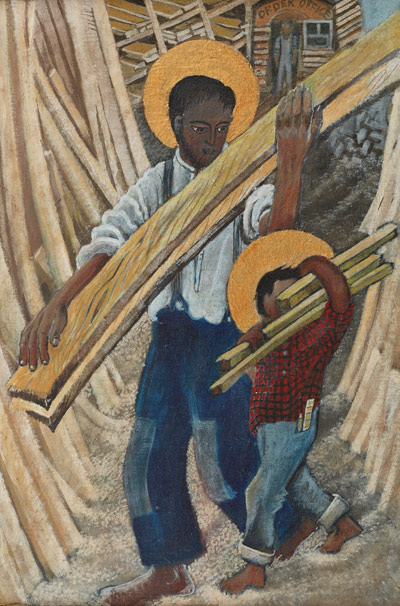Elizabeth Eularia Baines was born in London in 1914 and was the only daughter of Cuthbert Edward Baines, an agnostic novelist and Civil Servant, and Margaret Lane Poole.
Educated at St Paul’s Girl’s School Eularia showed an early flair for both music and art. Music was encouraged in the family, two of her brother’s being Anthony and Francis Baines, both well-known musicians in their day.
On a visit to Florence in Easter 1931 she visited San Marco. Drawn to religion and its mystery from an early age, despite an agnostic father, she was captivated by the frescoes of Fra Angelico and Giotto and immediately began painting gospel scenes.
She won a scholarship to St Anne’s College Oxford and studied Theology hoping that it would help her to understand the mystery and divinity of God, but hated the dry, theoretical, and critical nature of the teaching. She maintained that this actively put her off religion for the next 20 years. In her opinion the best thing about Oxford were the life classes she took in her spare time at the Ruskin School of Art under Gilbert Spencer, Barnett Freedman and Albert Rutherstone.
In 1937 she married Cyril Clarke, a talented, but penniless musician, and by 1941 had two children. She called these years her blank years because she did no real painting, only frequent sketches of her children and the world around her. By the time the war was over so was her marriage. Eularia never had any help from Cyril, financial or otherwise and took jobs teaching recorders and guitar wherever she could to support herself and her children.
In 1949 she moved to Winchester and in 1956 met John Stallard, a young musician who was also a Catholic. This awoke her interest in religion and she converted to Catholicism in 1959. In 1960, after losing a breast to cancer, she went on a pilgrimage to Lourdes, which inspired her to sketch the patterns of worship around her. It was there that she found the power to paint again and she turned the sketches into oils.
She began to paint scenes of local worship and this gradually developed into illustrations from the gospels. As she put it, having started with people in modern day dress it made no sense to start inserting people in biblical dress and in biblical settings, she just carried on and so the Gospels were set in the same surroundings that her scenes of worship were set in – the everyday England of the 1960s. She saw this as her ministry, seeing the gospels come alive in the here and now, in everyday life, rather than being a distant historical event.
Over the next 10 years she exhibited regularly, with others and alone, in the South of England and was interviewed more than once for television. The cancer returned in 1967 this time in the lung, but she continued painting and exhibiting for another three years before she finally died in November 1970.
A full illustrated biography is now available from Amazon. Eularia Clarke: Painter of Religion by Rebecca Sherlaw-Johnson priced £14.99/$19.99/ €17.87.
